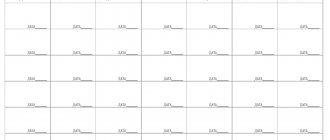Joint and independent activities of children during the day within the framework of the Federal State Educational Standard for preschool education
Alla Boldyreva
Joint and independent activities of children during the day within the framework of the Federal State Educational Standard for preschool education
Author: Boldyreva Alla Aleksandrovna, senior teacher of MKDOU DS “Buratino”
Lagan
1 slide. Dear colleagues. Today I want to share with you the experience of our kindergarten "Buratino"
— on organizing work with children during
the day . The Federal State Educational Standard is aimed at changing the forms of organizing work with children.
2slide. All children’s time in preschool educational institutions consists of activities : play, educational , work, joint , independent, and so on . Today we will focus on the latter.
3 slide. As Jan Amons Komensky said, “Children always willingly do something. This is very useful, and therefore not only should it not be interfered with, but measures must be taken to ensure that they always have something to do.” Our children are doers , whys, researchers. Modern documents are ready to see children like this , time dictates its changes. This means: we change ourselves, we change the environment for our children . Teachers, especially “trainees”
, we need to rebuild in order to live in the context of
the Federal State Educational Standard .
4 slide. The main task of the Federal State Educational Standard is to create conditions for children's activities . Where every child could, if desired, find an activity in any direction. To do this, you need to make the environment more vibrant, diverse , rich, and rich in content. Accessible - all paraphernalia should be of different levels of complexity: easy, medium complexity and complex. The child has the right to choose different levels of difficulty. The teacher, knowing the abilities of his students, can carefully suggest choosing a level that corresponds to his current capabilities (reach a more complex one or take an easier one)
.
The main thing is to give age-appropriate tasks to make it easier, so that we know that the children can handle it. One of the priority areas for implementing the Federal State Educational Standard is interaction with parents. In order for parents to become active participants in upbringing, they need to see that their children are developing while engaging in various activities , then they will definitely help and join the joint process .
5 slide. In each kindergarten, in groups, there are already various centers for children’s activities : art, experimentation, play, etc.
6 slide. Each teacher has a lot of accumulated benefits and material lying around. We must make sure that they “go among the people”
, that is, they were used in work and reached
the children . If you are concerned about the aesthetic appearance of the manuals, you can laminate them and place them in a file. Thus , we must make paraphernalia so that it is aesthetically pleasing, beautiful, comfortable and durable
. 7-8 slide. Our task now is to properly organize activities in various centers , to interest the child. Namely: to fill these centers with file cabinets of algorithms, diagrams, and operational maps. If the material is stored and placed at the center of the activity, children can always use it. In some places the material changes frequently, in others less often.
Our preschool educational institution held a competition of card files for joint and independent activities . These are algorithms, diagrams, sample drawings that will help us in organizing independent activities . Children do not need to be explained or reminded, we can simply say: “ pay attention ”
….
The more children we let go , the more results we get. Of course, at the beginning of joint activities , everything should be discussed, explained, taught to children to “read”
these diagrams, algorithms, you can come up with a game of a developmental nature.
Slide 9.. You ask, how can you keep all the children with different activities ? To do this, you need to make the environment interesting and varied with signs and diagrams, so that the child, while studying them, develops and gets involved in any type of activity .
Any teacher knows when there is a “worker”
noise - children are busy with things, they are involved in
joint activities and feel that the adult is not “above”
, but
“nearby”
.
This is a personality-oriented approach - adults need to rise to their level. Then the children take this activity home and involve their parents.
10 slide. The regimen is introduced in the morning. When a child comes early, he can be trained by doing his work, he will show it to others. After all, we get 80% of information from each other. The children's audience also learns from each other. The main thing is to light one, the rest will go on its own . Thus , we will distribute not 20% in a short time, but 80%.
11 slide. Work according to the algorithm (scheme)
Different centers will have their own algorithms of action. The child chooses a certain scheme at his own request and acts according to it. For example, the center of experimentation may be algorithms with an image of mixing colors to obtain a new, algorithm
etc.
In the play area there is a diagram of how to braid a braid, do a hairstyle, and choose a hairpin according to color and size. Not only gaming problems are solved, but also educational ones (decorate, educational (fine motor skills development)
.
We also hang an algorithm in the physical activity center - but the paraphernalia is always monotonous . To increase interest, the gate can be made in the form of fruit.
At the center of nature is an algorithm for planting onions, seeds, and caring for flowers. Sometimes teachers have a fear that the children will do the wrong thing and get dirty. In this case, it is better to do it together with the child (planting onions, or do it with 2-3 children (working with scissors)
. We must create an algorithm so that the child wants to act.
12 slide. We are already working according to the Federal State Educational Standard , we don’t conduct classes, but we still see a vernissage of children’s work hanging with snowmen with identical buckets, noses in one direction, with a broom in one hand. Obviously "work according to the model "
.
And in order to work according to the Federal State Educational Standard , we need to make a little more options: offer children large and small circles, backgrounds of different colors, a set of carrots, buckets, paper of different textures, etc. All this can be offered at once. The child should have a choice: places, plan, time (I will do this after an evening walk, when I play)
.
(show folder)
Working according to operational cards
(typesetting sheets, folding beds)
- creates a desire to act, to create several models.
In younger groups, you should use clamshells, where the prepared material is stored step by step in the pockets, for example, for the application “Snowman”
: 3 circles, a bucket, a carrot.
In order for a small child to express himself, you need to offer him a lot of different materials (snow, twigs, etc.)
.
Having taught children to be independent , work becomes easy.
Slide 13 Centers must be replenished and updated regularly. An active should be applied here - to replenish the centers of activity with the help of joint activities with attributes on the topic . (Photo of the store)
Within
the framework “Shop”
play area, coins can be leaves in the fall, snowflakes in the winter, flowers in the spring, fruits in the summer, etc., which the children made during the GCD.
If children make paraphernalia themselves according to a pattern, then this also develops. By preparing wrestlers from salted dough of different shapes according to the diagram, children fix the shape and names. By playing the game "Shop"
, along with the existing attributes, you can add these developmental attributes to the game center.
Everything that is produced in direct educational activities can be distributed throughout all play areas. Children will develop every day using our “good”
.
Slide 14 Teachers can exchange files of algorithms and schemes among themselves. There should be a lot of everything, the environment should be rich. How to organize this? Today there are a lot of advertisements, catalogs distributed free of charge in supermarkets that come by mail. For example: work in the mathematics center: children choose blanks for numbers and cut out objects for them. In this case, you can use magazines, catalogues, advertising: - for the number 3 - cut out three bottles of butter, for the number 6 - six loaves of sausage. Previously, teachers made preparations for all children , but now it’s different: in each activity center there is a little bit of everything. This will be much more effective since the child has a choice. The first ones chose, the rest, after looking, will want it. And the whole group will do this. An adult just remembers to encourage independence and imagination.
A rich developmental environment is an important condition that encourages the child to play independently and work .
The free activity of pupils in the context of a subject-specific developmental educational environment ensures that each child chooses activities according to his interests and allows him to interact with peers or act individually.
Of course, the whole group will not start working according to the algorithms right away; this should be achieved in stages: first once a week in the afternoon, then every other day, gradually bringing it to a habitual pastime.



